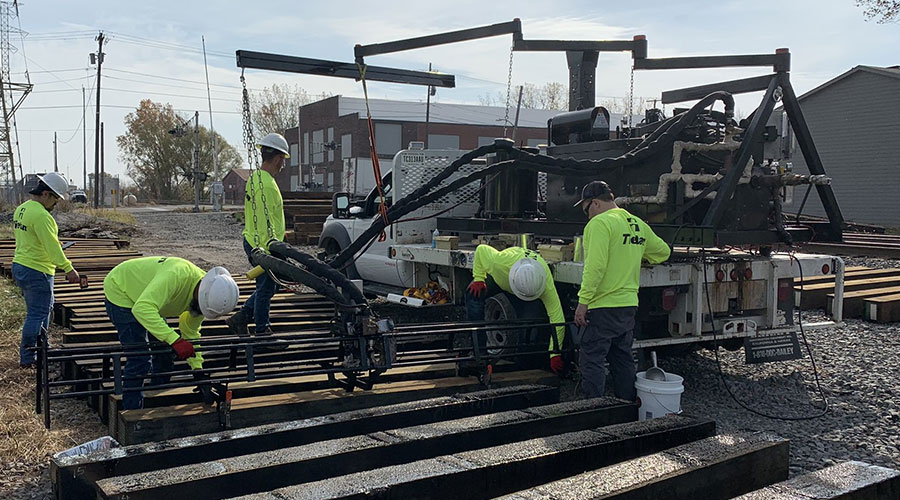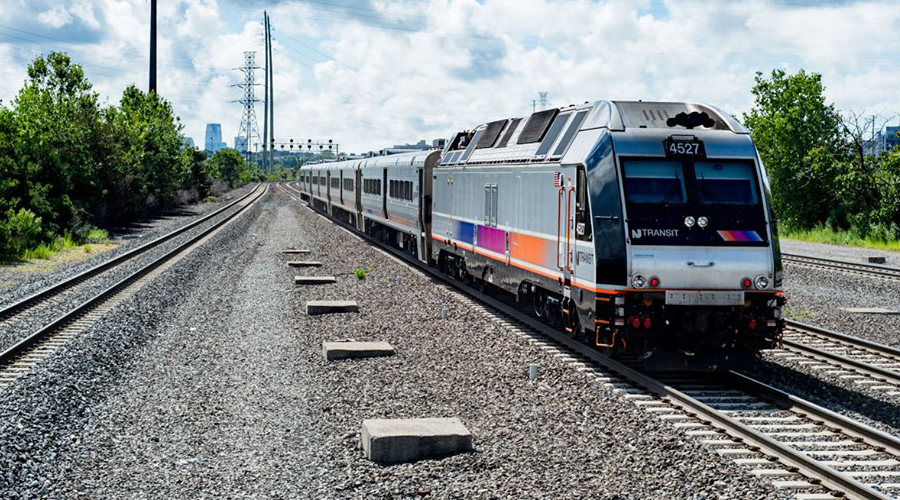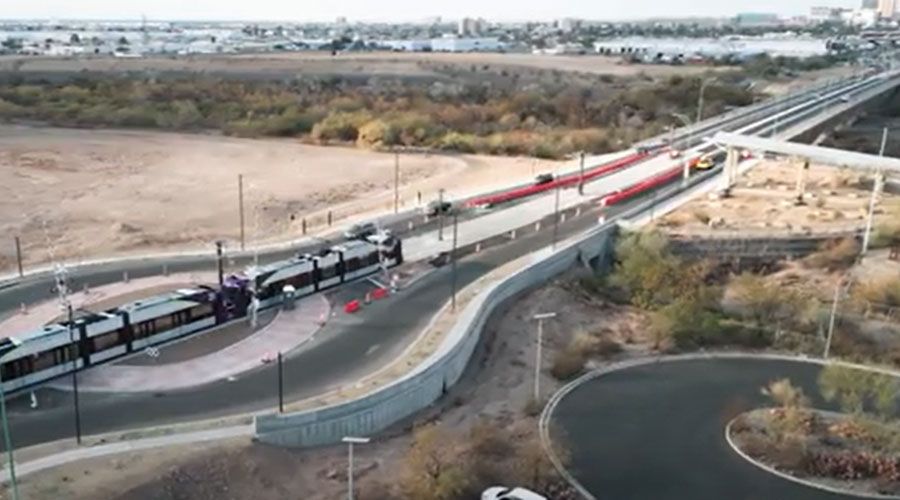Stay updated on news, articles and information for the rail industry
6/9/2023
Rail News: Canadian Pacific Kansas City
The next step for CPKC: Fully fusing and fostering growth as the newest Class I
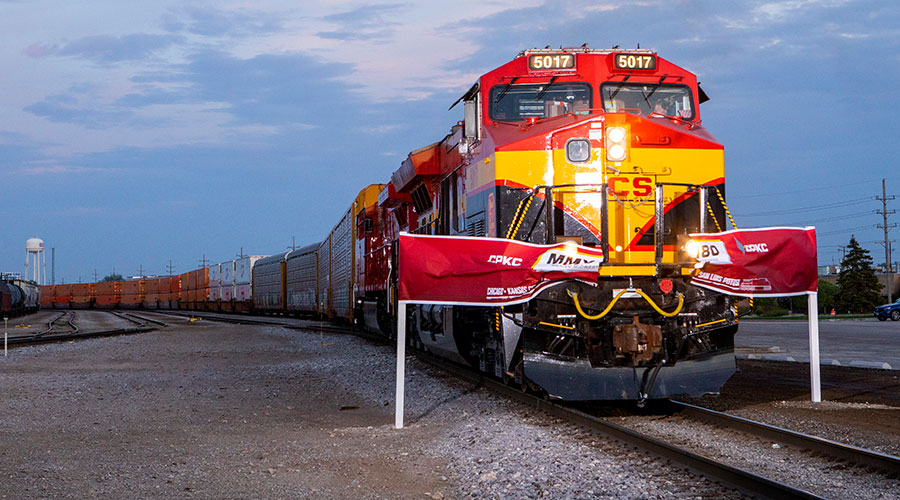
By Jeff Stagl, Managing Editor
An avid runner, Keith Creel’s wife Ginger has tried repeatedly to convince him to participate in a marathon.
The former Canadian Pacific leader who’s now president and CEO of Canadian Pacific Kansas City (CPKC), Creel ran in a few half marathons but resisted taking on a full one.
Yet, he’s experienced something of late that was similarly long, grueling and imposing: the two-year grind to combine CP and Kansas City Southern into CPKC.
That arduous effort involved forging two separate merger agreements with KCS, and fending off a CN attempt to combine with KCS in between; seeking Surface Transportation Board (STB) approval; overcoming a litany of objections; addressing myriad questions or concerns about the combination; and forging a solid integration strategy to be ready if CPKC crossed the finish line.
“I think I just ran an ultramarathon,” said Creel on March 16 — the day after the STB issued its favorable merger decision — during an online J.P. Morgan Industrials Conference.
But a lot more endurance will be required by Creel & Co. to kickstart and drive CPKC. A newly formed executive leadership team now faces the challenge of fully integrating the two Class Is, forging and nurturing an entirely new organization, and cashing in on the new railroad’s reach and promise. The integration process alone could last up to three years.
Combining the more than 140-year-old CP and more than 130-year-old KCS created the only single-line rail network in North America that connects Canada, the United States and Mexico. CPKC is the only East-West railroad that runs between the U.S. Northeast and Atlantic Canada to Texas and Mexico, and to the upper U.S. Midwest from Mexico, Texas and Louisiana.
The Class I’s 20,000-mile network reaches some points that no other large railroad can match in terms of strategic port facility access and gateways with short lines and other Class Is.
“We uniquely, only and solely bring three nations together — it’s never been done before. I would suggest it will never be done again,” said Creel.
In addition to Creel, the new exec leadership team includes Executive Vice President and Chief Financial Officer Nadeem Velani; EVP and Chief Marketing Officer John Brooks; EVP and Chief Operating Officer Mark Redd; EVP and Chief Transformation Officer John Orr; EVP of Strategic Planning and Technology James Clement; and CPKC Mexico President, General Manager and Executive Representative Oscar Augusto Del Cueto Cuevas. Orr previously was KCS’ EVP of operations while the others served in the same or different roles at CP.
Former KCS President and CEO Patrick Ottensmeyer is serving as an adviser to Creel for the remainder of 2023 to help ensure continuity on some key initiatives, predominantly those involving the combined organization and Mexico.
PSR part of operating plan
Prior to receiving the STB’s approval, the team spent a lot of time meeting and “whiteboarding” ideas/methods as to how CPKC would operate from Day One. They needed to address operations, information technology (IT) systems, financial processes, the workforce, assets, infrastructure and other aspects of the two organizations.
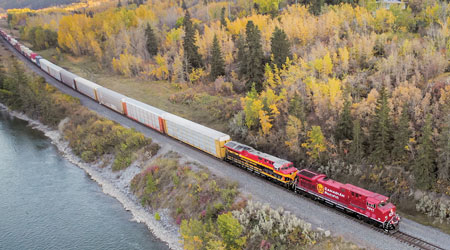
One vital yet extremely complex task was developing an integrated operating plan that incorporated precision scheduled railroading (PSR), which CP leaders long have considered a key ingredient to optimal service performance. The team took a measured approach to plan development and performed stress tests to ensure all necessary elements were in place and the combined entity could operate as intended from the start.
“[PSR] will be part of our DNA as long as I have anything to do with this railroad or anything to do with the people that run this railroad when I’m gone,” said Creel during CPKC’s first-quarter earnings conference on April 26. “You make sure that the local jobs are right, the road performance is right. You make sure the stops and the times you switch your customers are correct and you’re properly resourced to optimize that plan.”
For CP and KCS — the two smallest Class Is for a prolonged time — it helped integration-wise that they had similar corporate cultures, and their management teams employed like-minded and customer-focused operating strategies.
For others in the rail industry, it helped that the CPKC brain trust achieved the integrated operating plan’s main goal for regulators as of the April 14 launch: to keep gateways open, respect contract terms and pursue resolutions for any traffic issues that arose for shippers, other railroads or other stakeholders.
“We made a service promise to the STB. It was an unprecedented commitment to them,” says Jonathan Wahba, now CPKC’s senior vice president of sales and marketing after serving as CP’s VP of commercial integration for two years.
Moving forward, other integration components will continue to be implemented for some time, and they need to be carried out as planned, said Creel. The rail industry doesn’t have a solid history of major railroads merging without a hitch — a la the late 1990s service meltdowns associated with Southern Pacific-Union Pacific marriage and the Conrail split between CSX and Norfolk Southern Railway.
“I’ve lived through some integrations that history shows did not go well, and I participated in some that have. We did not underestimate the magnitude of this,” said Creel. “We will integrate well because the last thing we need to do obviously is not provide safe and efficient service for our customers as we bring these two roads together. We hit the ground running.”
CPKC needs to develop a reputation as a merged railroad that accomplished what it set out to do, he stressed.
“There’s one thing I am committed to and that’s history reflecting well on us, and that it’s reflected well on those who trusted us to bring these two great companies together,” Creel said.
All eyes on integration
For the past 10 months, an integration management office chaired by Creel has worked to ensure cadence. There are more than 165 processes or plans in place that define aspects of integration, from payroll to real estate management to customer relations, said Creel.
On May 8, teams from CP and KCS conducted an alignment meeting in Calgary, Alberta, to talk about new standards and exceptions.
“We want to make sure to time every job we have, the connections, and understand what freight goes where and just align ourselves. We want to make sure the local jobs are right,” said Creel.
IT platform systems integration is a key operational aspect, such as systems applications and products, and online customer tools. For example, CP’s and KCS’ web-based carbon calculators aren’t yet integrated but are expected to reach that point soon.
The STB’s long and drawn-out approval process was a silver lining because it provided the leadership team more time for pre- and post-merger integration planning, says Wahba.
“Some of these are long-cycle processes. Mega deals tend to take months or years to accomplish,” he says.
CPKC now is striving to be the safest and most reliable railroad per its commitment to the STB, shippers, employees, shareholders and other stakeholders, so this isn’t the time for operational performance to worsen, says Wahba. That management objective was going strong into June — no service or safety issues had arisen as of press time.
“The tracks in the ground are the same, it’s the people managing them who are different,” says Wahba.
To maintain service performance, CPKC aims to methodically bring on business so the network isn’t overloaded and overtaxed. The company shouldn’t “get ahead of its skis” and oversell right at the start, Creel stresses.
“I think our customers, as much as they would love the benefits of this network … would much rather appreciate our honestly as we say, ‘Not yet, we’re not ready yet,’ than we just bring them on and we fail them,” he said. “We’re not going to fail by letting our aggressiveness and our want for revenue over-subscribe our ability to execute.”
Any “boiling of the ocean” would be fraught with peril, such as an attempt to move all the autos produced in Mexico that need to be transported north, says Wahba.
“We can’t move all of those autos. We want to be thoughtful about taking on more business,” he says.
Mining intermodal markets
Not that CPKC hasn’t already landed big chunks of new business, specifically in the intermodal sector. In late April, the railroad landed a multiyear agreement with Schneider National Inc. to provide intermodal transportation service between the United States and Mexico.
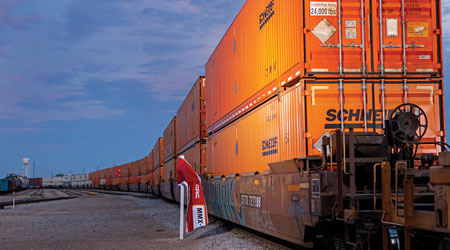
Schneider — which began to transition its Mexico-U.S. traffic to CPKC in mid-May — now serves as an anchor customer for the railroad’s flagship north-south domestic intermodal service between Chicago and all major destinations in Mexico.
CPKC leaders tout the Class I’s international railroad bridge over the Rio Grande River at the U.S.-Mexico border in Laredo, Texas, as an alternative to congested highway ports of entry. A second bridge span that will expand capacity and further increase the efficiency of cross-border train movements is under construction and expected to be completed by 2024’s end.
Controlling more than 28,000 trailers, Schneider owns one of the largest intermodal fleets in North America. The company plans to double the size of its intermodal business by 2030.
CPKC’s intermodal service speed and efficiency is comparable to over-the-road transportation, but with the added benefit of sustainability, Schneider officials said in a press release.
Not quite a week after announcing the Schneider deal, CPKC unveiled a multiyear agreement with Knight-Swift Transportation Holding Inc. to provide intermodal services connecting freight moving between Mexico, the United States and Canada.
One of North America’s largest and most diversified freight transportation companies, Knight-Swift provides truckload transportation and logistics services. The company’s Mexico customer base now can tap the railroad’s lines, terminals and cross-border access to gain more reliable and competitive service, CPKC officials say.
Knight-Swift transitioned its Mexico-U.S. traffic to CPKC in mid-May. Now, the partners are focusing on growing intermodal traffic between markets in Chicago, Texas and Mexico.
One carrier is quite compelling
Schneider and Knight-Swift were attracted by the prospect of using a single-line rail carrier and the promise of reducing freight touch points, says Wahba.
“They don’t have to put together routings with two railroads — they only have to deal with one railroad,” he says. “They want to compete with their competitors, but it’s all about taking trucks off the roads. That’s the bigger opportunity.”
As a single-line carrier, CPKC can offer better transit times, less freight damage since there’s fewer handlings, one waybill, one electronic data interchange and one operating team.
“Just one of those things doesn’t really move the needle. But when you stack them on top of each other, it’s compelling,” says Wahba.
Mexico continues to be a compelling intermodal market. CPKC’s count shows more than 300 companies desire to build or expand plants in that nation, says Wahba.
That’s why CPKC in May launched a Mexico Midwest Express (MMX) Series intermodal service. It links the Chicago, Kansas City and Texas markets in the United States with the Monterrey and San Luis Potosi markets in Mexico. The railroad offers third-day service to and from Laredo, fourth-day service to and from Monterrey, and 4.5-day service to and from San Luis Potosi.
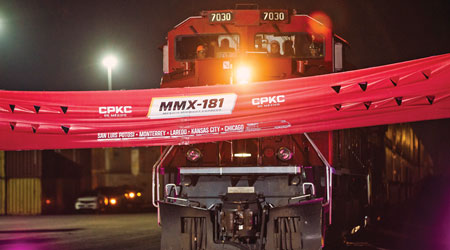
The MMX Series’ total transit time from Chicago to San Luis Potosi is 98 hours — a day faster than any transit time offered by competitors, CPKC officials say.
The service’s debut on May 11 involving trains MMX-180 and MMX-181 ran ahead of schedule, says Wahba.
“We can make [the full trip] in the same time some carriers go from Laredo to Chicago, but we start many more miles south. That shows customers that they can win in their markets,” he says.
Much more to come
There are other intriguing things the railroad plans to offer soon, but details on potential new or enhanced services or additional partnerships won’t be shared until CPKC’s annual shareholders meeting on June 15, says Wahba. CPKC execs also will provide details on the Class I’s business plan at the event.
In addition to intermodal offerings, new services might address underutilized deepwater ports, the railroad’s automotive, grain and refrigerated freight businesses, and its bulk franchise in Canada, says Wahba.
It’s an exciting time at CPKC and invigorating to be a part of something that poses such big potential, he says. The two-year federal approval process was strenuous, but worth the stress.
“We’ve been waiting a long time for Christmas morning. There is no other railroad in the world like us that can offer these solutions,” says Wahba.
The main takeaway from CPKC’s formation? That the combined entity creates the most relevant rail network in North America, Creel believes. And just wait until the Class I is fully integrated come 2026.
“The next three years will be extremely exciting, but it’s what lies beyond that excites me the most,” Creel said.
Email questions or comments to jeff.stagl@tradepress.com.
Contact Progressive Railroading editorial staff.


 2025 MOW Spending Report: Passenger-rail programs
2025 MOW Spending Report: Passenger-rail programs
 Gardner steps down as Amtrak CEO
Gardner steps down as Amtrak CEO
 Guest comment: Oliver Wyman’s David Hunt
Guest comment: Oliver Wyman’s David Hunt
 Women of Influence in Rail eBook
Women of Influence in Rail eBook
 railPrime
railPrime





